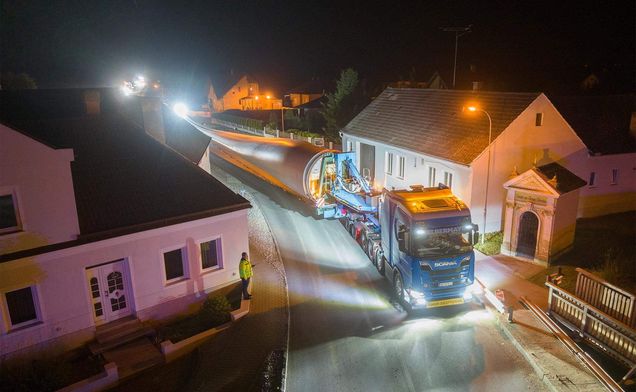Transport and lifting technology for wind power giants
October 5, 2023 | Lucia Reinsprecht
“Higher, faster, more powerful” is the motto that can be used to summarise the current development trend in the expansion of wind energy. Impressive example of the enormous progress in the wind energy industry: Whereas the rotor diameter of onshore turbines was mostly less than 50 metres until the early 2000s, this has more than doubled to up to 163 metres by 2022.
This trend is also followed by the project of the wind power company Windkraft Simonsfeld in Dürnkrut in Lower Austria. The specialists from Felbermayr Transport and Lifting Technology were assigned to transport and assemble the three new wind power giants.
Special transporter BladeS in use
The transport of the new, state-of-the-art Nordex DELTA 4.000 wind turbines began in mid-May. Around 27 special transports were required for this. Among them are three wind vane transporters of the latest generation.
Since March 2022, Goldhofer's transport systems have been available for precisely such mega-projects at Felbermayr. Their speciality: the transport of rotor blades of almost gigantic dimensions. “With the BladeS, we have state-of-the-art technology at our disposal. Transporting rotor blades almost a hundred metres long is often a matter of working by the centimetre. We have to master tight curve radii again and again and need a high dimension of flexibility. Manufacturers have reacted and developed so-called follower concepts such as the BladeS. This essentially consists of two parts: A traction machine on which the rotor blade root rests and a trailing axle module with a slewing ring that holds its tip. This means the two components are only connected by the rotor blade and thus offer a high dimension of manoeuvrability,” explains Roland Füreder, project manager of the Wind Power department of Transport and Lifting Technology.
With this new transport system, it was possible to manoeuvre the wind blade giants, which are over 80 metres long and weigh around 30 tonnes, from Cuxhaven in northern Germany to Dürnkrut, about 1,350 kilometres away. A major project in which around 50 Felbermayr employees were involved in order to navigate them carefully through sometimes the smallest of villages. It took a total of five days before the valuable cargo was secured on the construction site in Lower Austria.
Installation 164 metres above ground level
After the eagerly awaited components reached their destination safely and undamaged, it was time for assembly. For this purpose, an LR 1800 lattice boom crawler crane with a loading capacity of up to 800 tonnes was previously erected by the Setup team. A real “muscleman”, with a main boom around 168 metres high and a 12-metre fixed tip, capable of safely carrying the system components weighing up to 80 tonnes to 164 metres.
The Felbermayr team was then limited in the speed at which it could erect the parts, because when cranes are used at such heights, it is important to keep a close eye on the weather conditions. “When lifting the rotor blades, the limit for wind speed is six metres per second, for the tower segments nine metres per second,” explains Tina Wagner, who is responsible for setting up the wind turbines in conjunction with the transports. As the responsible project manager at Felbermayr Lifting Technology, she is very familiar with the challenges of such projects. This includes, among other things, the demanding transport logistics of the crane giants as well as cramped spatial conditions for the assembly of the cranes on site.
The order was completed by Felbermayr in mid-August. The new wind turbines have been connected to the grid since mid-September. With a nominal output of 17.1 megawatts, this will produce almost 50 million kilowatt hours of power. In total, the new systems supply a comparative total of 12,400 households with power from renewable energy.





